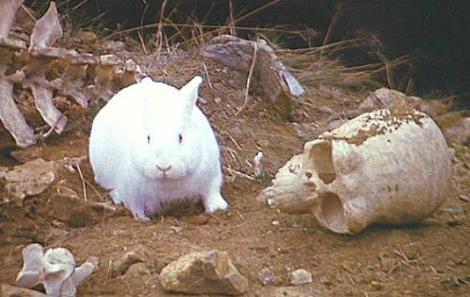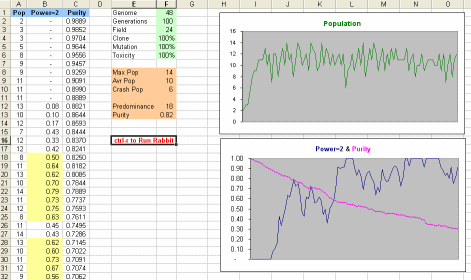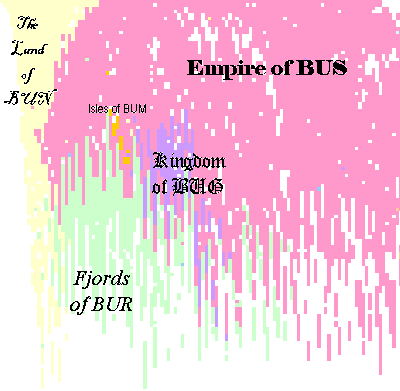 |
|
 |
|
 So you want to learn the ways of Killer Rabbits. Killer Rabbits kill everything they encounter! Run away! Run away! You have been warned. |
|
|
This project started with a
discussion on Telic Thoughts about Wonders
for Oyarsa's Amazing
Toxic Asexual Bunny Mutation Simulator.
Wonders for Oyarsa blogged, Then I remembered that we have around 96% genetic similarity to the chimpanzee - meaning large chunks of our genome can be matched up with chunks of the chimp genome almost exactly. These things seem completely at odds to me. If a portion of the genome is junk, than there should be no selective pressure to keep this portion the same. In fact, there may be a functional advantage in removing it altogether (the organism can get by with less nucleotides in its cells). Over 5 million years, it certainly feels like these junk sections would become completely scrambled, rather than maintaining almost total similarity. [Emphasis added.] |
 In order to test
Wonders for Oyarsa's intuition, I modified
Zachriel's Nest
of Letters which concerned neutral evolution. According to Wonders
for Oyarsa's Toxic Bunny rules, Genomes are
subject to selection for fitness. Each Generation
a Killer Rabbits can
attack one or more Killer Rabbits.
The number of attacks depends on how crowded the Field is at that
time. Killer Rabbits can
have defenses against these attacks. Power, and hence fitness, is
defined by the first three letters of the Genome. In order to test
Wonders for Oyarsa's intuition, I modified
Zachriel's Nest
of Letters which concerned neutral evolution. According to Wonders
for Oyarsa's Toxic Bunny rules, Genomes are
subject to selection for fitness. Each Generation
a Killer Rabbits can
attack one or more Killer Rabbits.
The number of attacks depends on how crowded the Field is at that
time. Killer Rabbits can
have defenses against these attacks. Power, and hence fitness, is
defined by the first three letters of the Genome.
The Founding Genome is BUN,,,,, (with commas used to pad the Genome up to the desired length). It begins with a Power of one.
Press ctrl-r to Run Killer Rabbits. |

I warned you. This is the Result. |
 |
Run away! Run away! You have been warned.
On the left of the screen are recorded
the result of each Generation. It includes the surviving Population
of Killer Rabbits, the percentage of the Population
that has the BUG mutation
(Power=2), and the Purity
of the Population. The graphs give some idea of how the Killer Rabbits evolve over time. Population is the green line on the upper graph. On the lower graph, the blue line is the Power while the pink line is the Purity.
Notice all the various mutations that have been tried. But have since disappeared!
Of all these, only the R! and D persist. Only a single change to the Junk Genome remains after 10 Generations. The rest were tried and discarded. Meanwhile, selection for fitness preserved the BUR strain. |
|
Snippets of Code! This function calculates the Power of a Genome.
Instead of bouncing fluffy bunnies around the screen, not-so-fluffy Killer Rabbits randomly encounter one another proportioned by how crowded they are in the Rabbit Field, numChildren/maxMembers.
|
|
Some Results! Following is the result with Genome = 200, Field = 100, Generations = 100. The pink line is Purity, that is, how much of the original sequence has been left untouched. Notice that Purity forms a nearly straight line. On the same graph is the proportion of the BUG mutation. Notice that once the BUG mutation occurs, it rapidly predominates in the Population. But because they still prey on one another, they never quite stabilize at 100% fixation.
This scenario reached 50% BUG predominance on Generation = 13 with 97% Purity.
The following example is with a large Genome but a relatively small Field. Even with the very late onset of the BUG mutation, Purity is still very high.
|
||||||||||||||||||||||||||||||||||||||||||||||||||||||||||||||||||||||||||||||||||||||||||||||||||||||||||||||
| Genome = 2000, Field = 100, Generations = 255 | |
| POPULATION ONE | POPULATION TWO |
| BUR,,,,,,W,,,,,,,,,,,,,,,,D,,,,,,,,,,,,,,,,,,,,,,, | BUG,,,,,,,,,K,,,,,,,,,,,,,,,J,,,,N,,,,,,,,,,,,,,,, |
| BUR,,,,,,W,,,,,,,,,,,,,,,,D,,,,,,,,,,,,,,,,,,,,,,, | BUG,,,,,,,,,K,,,,,,,,,,,,,,,J,,,,N,,,,,,,,,,,,,,,, |
| BUR,,,,,,W,,,,,,,,,,,,,,,,D,,,,,,,,,,,,,,,,,,,,,,, | BUG,,,,,,,,,K,,,,,,,,,,,,,,,J,,,,N,,,,,,,,,,,,,,,, |
| BUR,,,,,,W,,,,,,,,,,,,,,,,D,,,,,,,,,,,,,,,,,,,,,,, | BUG,,,,,,,,,K,,,,,,,,,,,,,,,J,,,,N,,,,,,,,,,,,,,,, |
| BUR,,,,,,W,,,,,,,,,,,,,,,,D,,,,,,,,,,,,,,,,,,,,,,, | BUG,,,,,,,,,K,,,,,,,,,,,,,,,J,,,,N,,,,,,,,,,,,,,,, |
| BUR,,,,,,W,,,,,,,,,,,,,,,,D,,,,,,,,,,,,,,,,,,,,,,, | BUG,,,,,,,,,K,,,,,,,,,,,,,,,J,,,,N,,,,,,,,,,,,,,,, |
| BUR,,,,,,W,,,,,,,,,,,,,,,,D,,,,,,,,,,,,,,,,,,,,,,, | BUG,,,,,,,,,K,,,,,,,,,,,,,,,J,,,,N,,,,,,,,,,,,,,,, |
| BUR,,,,,,W,,,,,,,,,,,,,,,,D,,,,,,,,,,,,,,,,,,,,,,, | BUG,,,,,,,,,K,,,,,,,,,,,,,,NJ,,,,N,,,,,,,,,,,,,,,, |
| BUR,,,,,,W,,,,,,,,,,,,,,,,D,,,,,,,,,,,,,,,,,,,,,,, | BUG,,,,,,,,,K,,,,,,,,,,,,,,NJ,,,,N,,,,,,,,,,,,,,,, |
| BUR,,,,,,W,,,,,,,,,,,,,,,,D,,,,,,,,,,,,,,,,,,,,,,, | BUG,,,,,,,,,K,,,,,,,,,,,,,,NJ,,,,N,,,,,,,,,,,,,,,, |
| BUR,,,,,,W,,,,,,,,,,,,,,,,D,,,,,,,,,,,,,,,,,,,,,,, | BUG,,,,,,,,,K,,,,,,,,,,,,,,NJ,,,,N,,,,,,,,,,,,,,,, |
| BUR,,,,,,W,,,,,,,,,,,,,,,,D,,,,,,,,,,,,,,,,,,,,,,, | BUG,,,,G,,,,K,,,,,,,,,,,,,,,J,,,,N,,,,,,,,,,,,,,,, |
| BUR,,,,,,W,,,,,,,,,,,,,,,,D,,,,,,,,,,,,,,,,,,,,,,, | BUG,,,,G,,,,K,,,,,,,,,,,,,,,J,,,,N,,,,,,,,,,,,,,,, |
| BUR,,,,,,W,,,,,,,,,,,,,,,,D,,,,,,,,,,,,,,,,,,,,,,, | BUG,,,,G,,,,K,,,,,,,,,,,,,,,J,,,,N,,,,,,,,,,,,,,,, |
| BUR,,,,,,W,,,,,,,,,,,,,,,,D,,,,,,,,,,,,,,,,,,,,,,, | BUG,,,,G,,,,K,,,,,,,,,,,,,,,J,,,,N,,,,,,,,,,,,,,,, |
| BUR,,,,,,W,,,,,,,,,,,,,,,,D,,,,,,,,,,,,,,,,,,,,,,, | BUG,,,,,,,,,K,,,,,,,,,,,,,,,J,,,,N,,,,,,,,,,,,,,,, |
| BUR,,,,,,W,,,,,,,,,,,,,,,,D,,,,,,,,,,,,,,,,,,,,,,, | BUG,,,,,,,,,K,,,,,,,,,,,,,,,J,,,,N,,,,,,,,,,,,,,,, |
| BUR,,,,,,W,,,,,,,,,,,,,,,,D,,,,,,,,,,,,,,,,,,,,,,, | BUG,,,,,,,,,K,,,,,,,,,,,,,,,J,,,,N,,,,,,,,,,,,,,,, |
| BUR,,,,,,W,,,,,,,,,,,,,,,,D,,,,,,,,,,,,,,,,,,,,,,, | BUG,,,,,,,,,K,,,,,,,,,,,,,,,J,,,,N,,,,,,,,,,,,,,,, |
| BUR,,,,,,W,,,,,,,,,,,,,,,,D,,,,,,,,,,,,,,,,,,,,,,, | BUG,,,,,,,,,K,,,,,,,,,,,,,,,J,,,,N,,,,,,,,,,,,,,,, |
| BUR,,,,,,W,,,,,,,,,,,,,,,,D,,,,,,,,,,,,,,,,,,,,,,, | BUG,,,,,,,,,K,,,,,,,,,,,,,,,J,,,,N,,,,,,,,,,,,,,,, |
| BUR,,,,,,W,,,,,,,,,,,,,,,,D,,,,,,,,,,,,,,,,,,,,,,, | BUG,,,,,,,,,K,,,,,,,,,,,,,,,J,,,,N,,,,,,,,,,,,,,,, |
| BUR,,,,,,W,,,,,,,,,,,,,,,,D,,,,,,,,,,,,,,,,,,,,,,, | BUG,,,,,,,,,K,,,,,,,,,,,,,,,J,,,,N,,,,,,,,,,,,,,,, |
| BUR,,,,,,W,,,,,,,,,,,,,,,,D,,,,,,,,,,,,,,,,,,,,,,, | BUG,,,,,,,,,K,,,,,,,,,,,,,,,J,,,,N,,,,,,,,,,,,,,,, |
| BUR,,,,,,W,,,,,,,,,,,,,,,,D,,,,,,,,,,,,,,,,,,,,,,, | BUG,,,,,,,,,K,,,,,,,,,,,,,,,J,,,,N,,,,,,,,,,,,,,,, |
| BUR,,,,,,W,,,,,,,,,,,,,,,,D,,,,,,,,,,,,,,,,,,,,,,, | BUG,,,,,,,,,K,,,,,,,,,,,,,,,J,,,,N,,,,,,,,,,,,,,,, |
| BUR,,,,,,W,,,,,,,,,,,,,,,,D,,A,,,,,,,,,,,,,,,,,,,, | BUG,,,,,,,,,K,,,,,,,,,,,,,,,J,,,,N,,,,,,,,,,,,,,,, |
| BUR,,,,,,W,,,,,,,,,,,,,,,,D,,A,,,,,,,,,,,,,,,,,,,, | BUG,,,,,,,,,K,,,,,,,,,,,,,,,J,,,,N,,,,,,,,,,,,,,,, |
| BUR,,,,,,W,,,,,,,,,,,,,,,,D,,A,,,,,,,,,,,,,,,,,,,, | BUG,,,,,,,,,K,,,,,,,,,,,,,,,J,,,,N,,,,,,,,,,,,,,,, |
| BUR,,,,,,W,,,,,,,,,,,,,,,,D,,A,,,,,,,,,,,,,,,,,,,, | BUG,,,,,,,,,K,,,,,,,,,,,,,,,,,,,,G,,,,,,,,,,,,,,,, |
| BUR,,,,,,W,,,,,,,,,,,,,,,,D,,A,,,,,,,,,,,,,,,,,,,, | BUG,,,,,,,,,K,,,,,,,,,,,,,,,,,,,,G,,,,,,,,,,,,,,,, |
| BUR,,,,,,W,,,,,,,,,,,,,,,,D,,A,,,,,,,,,,,,,,,,,,,, | BUG,,,,,,,,,K,,,,,,,,,,,,,,,,,,,,G,,,,,,,,,,,,,,,, |
| BUR,,,,,,W,,,,,,,,,,,,,,,,D,,,,,,,,,,,,,,,,,,,,,,, | BUG,,,,,,,,,K,,,,,,,,,,,,,,,,,,,,G,,,,,,,,,,,,,,,, |
| BUR,,,,,,W,,,,,,,,,,,,,,,,D,,,,,,,,,,,,,,,,,,,,,,, | BUG,,,,,,,,,K,,,,,,,,,,,,,,,,,,,,G,,,,,,,,,,,,,,,, |
| BUR,,,,,,W,,,,,,,,,,,,,,,,D,,,,,,,,,,,,,,,,,,,,,,, | BUG,,,,,,,,,K,,,,,,,,,,,,,,,,,,,,G,,,,,,,,,,,,,,,, |
| BUR,,,,,,W,,,,,,,,,,,,,,,,D,,,,,,,,,,,,,,,,,,,,,,, | BUG,,,,,,,,,K,,,,,,,,,,,,,,,,,,,,G,,,,,,,,,,,,,,,, |
| BUR,,,,,,W,,,,,,,,,,,,,,,,D,,,,,,,,,,,,,,,,,,,,,,, | BUG,,,,,,,,,K,,,,,,,,,,,,,,,,,,,,G,,,,,,,,,,,,,,,, |
| BUR,,,,,,W,,,,,,,,,,,,,,,,D,,,,,,,,,,,,,,,,,,,,,,, | BUG,,,,,,,,,K,,,,,,,,,,,,,,,,,,,,G,,,,,,,,,,,,,,,, |
| BUR,,,,,,W,,,,,,,,,,,,,,,,D,,,,,,,,,,,,,,,,,,,,,,, | BUG,,,,,,,,,K,,,,,,,,,,,,,,,,,,,,G,,,,,,,,,,,,,,,, |
| BUR,,,,,,W,,,,,,,,,,,,,,,,D,,,,,,,,,,,,,,,,,,,,,,, | BUG,,,,,,,,,K,,,,,,,,,,,,,,,,,,,,G,,,,,,,,,,,,,,,, |
| BUR,,,,,,W,,,,,,,,,,,,,,,,D,,,,,,,,,,,,,,,,,,,,,,, | BUG,,,,,,,,,K,,,,,,,,,,,,,,,,,,,,G,,,,,,,,,,,,,,,, |
| BUR,,,,,,W,,,,,,,,,,,,,,,,S,,,,,,,,,,,,,,,,,,,,,,, | BUG,,,,,,,,,K,,,,,,,,,,,,,,,,,,,,G,,,,,,,,,,,,,,,, |
| BUR,,,,,,W,,,,,,,,,,,,,,,,D,,,,,,,,,,,,,,,,,,,,,,, | BUG,,,,,,,,,K,,,,,,,,,,,,,,,,,,,,G,,,,,,,,,,,,,,,, |
| BUR,,,,,,W,,,,,,,,,,,,,,,,D,,,,,,,,,,,,,,,,,,,,,,, | BUG,,,,,,,,,K,,,,,,,,,,,,,,,,,,,,G,,,,,,,,,,,,,,,, |
| BUR,,,,,,W,,,,,,,,,,,,,,,,D,,,,,,,,,,,,,,,,,,,,,,, | BUG,,,,,,,,,K,,,,,,,,,,,,,,,,,,,,G,,,,,,,,,,,,,,,, |
| BUR,,,,,,W,,,,,,,,,,,,,,,,D,,,,,,,,,,,,,,,,,,,,,,, | BUG,,,,,,,,,K,,,,,,,,,,,,,,,,,,,,G,,,,,,,,,,,,,,,, |
| BUR,,,,,,W,,,,,,,,,,,,,,,,D,,,,,,,,,,,,,,,,,,,,,,, | BUG,,,,,,,,,K,,,,,,,,,,,,,,,,,,,,G,,,,,,,,,,,,,,,, |
 Finally,
because all BUGs are
created equal, they drift in accordance with neutral evolution. Fixation
and extinction are the inevitable result. In most cases, the first BUG
quickly dominates the Population— so quickly that other BUGs
are crowded out. This is the Killer Rabbit
version of evolution's Founder Effect. Finally,
because all BUGs are
created equal, they drift in accordance with neutral evolution. Fixation
and extinction are the inevitable result. In most cases, the first BUG
quickly dominates the Population— so quickly that other BUGs
are crowded out. This is the Killer Rabbit
version of evolution's Founder Effect.
Genome = 100, Generations = 150, Field = 100 The Empire of BUS is unusual because two mutations arose simultaneously; BUS and BUR. It took many Generations for BUS to become predominant; and because of the relatively large Population will probably remain so for many a Generation to come. The Land of BUN, Fjords of BUR, Kingdom of BUG and Isles of BUM each had their time, but then slipped into history. |
 |
|